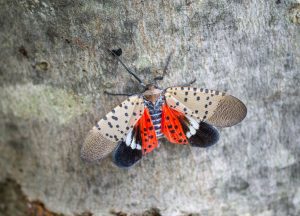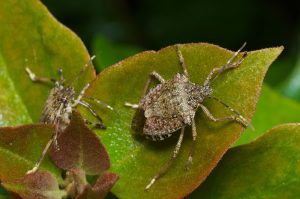New invasive insect threats
By Chris Williams on March 21, 2019.
As a backyard gardener, and orchardist, I’m always interested in keeping up with new exotic insect species arriving and becoming established in the US, because sooner or later they’ll be showing up at my place. Two of the top four ‘most wanted’ (at least according to one researcher) are present in my yard. One is the brown marmorated stink bug (Halymorpha halys) which is a tremendously destructive pest that, thankfully because of intense research, has become somewhat manageable along the East Coast where it first became established. It’s still a major nuisance pest there, entering homes in large numbers during fall. I haven’t heard of major crop damage being inflicted upon orchard fruit or vegetable growers in New England, or observed feeding injury on my fruit trees yet, but it is here and it does congregate on, and enter homes during the fall too. Fortunately, we don’t need shovels to gather them up yet. The second one is the spotted wing drosophila (Drosophila suzukii). It, too, is from Asia and it is a major headache for me with my backyard raspberries, and in particular my ‘fall’ crop. This pest was first discovered in California just 10 years ago so it moved in rather quickly. While most ‘fruit fly’ species are attracted to overripe, fermenting fruit, this little gem attacks fruit AS it’s ripening! They’ll rip into underside of my raspberries for example and deposit their eggs. Development happens very quickly and as that berry reaches perfection the center of it becomes a soupy mass of maggots. Trapping is the only viable control option for me because of the continued presence of pollinators. There are some decent lures out there for this pest and hopefully I’ll have my act together this summer so I don’t have to pick the berries as they are just coloring up.

Spotted Lanternfly. Shutterstock.
Yet another invasive species from Asia and a new threat for tree fruit and grape growers in the mid-Atlantic region is the Spotted Lanternfly. It’s apparently spreading to other states from Pennsylvania (Pennsylvania seems to be ground zero for many invasive species! ) in much the same fashion as the brown marmorated stink bug. The last one I’m going to mention here is the emerald ash borer (Agrilus planipennis). This small brilliant green colored beetle from Asia has very quickly (less than 20 years since it was first discovered in Michigan) earned the distinction of being the most destructive North American forest insect pest ever by destroying millions of ash trees in 35 states across the Mid-West, Eastern US and Canada

Brown Marmorated Stink Bug. Shutterstock.
In late February, it was discovered in three communities within York County Maine (Lebanon, Berwick, and Acton). According to officials with the Maine Forest service, emerald ash borer (EAB) appear to be established just 3 miles from the New Hampshire border. This is very close to where I live in New Hampshire.
For several years now I’ve seen the purple triangular sticky trap monitors hanging in ash trees during spring/summer throughout my travels for work and now its here. While none of these pests are structural and therefore out of our purview at Colonial Pest Control, I’m seeking to raise awareness about invasive insect species. Not a lot can be done to stop brown marmorated stink bug or spotted wing drosophila as they’re good flyers. Emerald ash borer is a strong flyer though it appears that it is primarily disseminated by transporting firewood and other products made of ash wood. For more, see https://extension.unh.edu/resource/best-management-practices-help-stop-spread-emerald-ash-borer-new-hampshire-rack-card